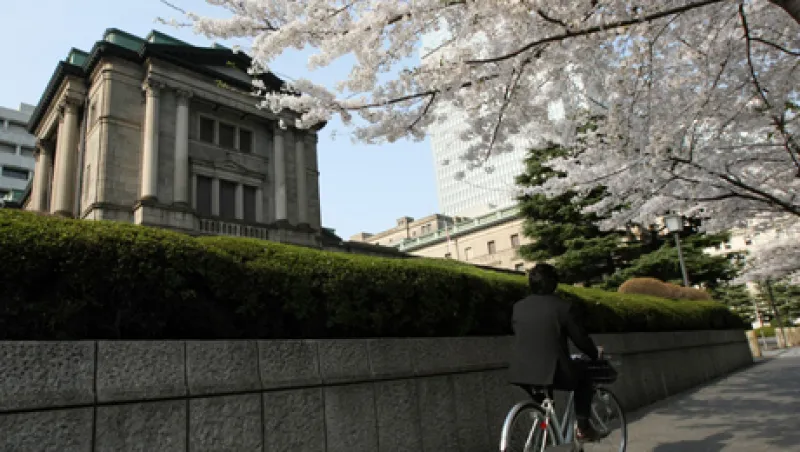Getting an ultra-conservative Bank of Japan to accept the idea that a little inflation could be a good thing is proving to be difficult for Prime Minister Shinzo Abe. The same is true of attempts to get cautious Japanese savers to adopt a more aggressive attitude toward managing their pension money.
The reticence of Japanese investors is evident in the slow growth of defined contribution pension plans. Such plans, which former prime minister Junichiro Koizumi introduced in 2001 as part of his economic reform program, are modeled on 401(k) plans in the U.S. These plans’ pension benefits depend on contributions and investment performance, and participants can select their own asset allocation, usually through mutual funds. Koizumi hoped the growth of these plans would foster an equity culture in Japan and relieve the burden on the country’s pay-as-you-go public pension system. The results have been rather less dramatic.
In March 2012, the end of Japan’s fiscal year, there were 4.22 million people enrolled in corporate defined contribution plans, and those plans held a total of some 6 trillion yen ($64 billion) in assets. By comparison, there were some 8 million participants in corporate defined benefit pension plans; those plans had total assets of 45 trillion yen. (Those figures do not include a further 4.1 million participants in Employee Pension Funds, a defined benefit–style fund sponsored by companies on behalf of employees.
A handful of big financial companies dominated the DC business, including Mizuho Financial Group, Nippon Life Insurance Co., Nomura Pension Support & Service, an arm of the securities firm, and Sumitomo Trust and Banking Co. Two other key players are joint ventures: Defined Contribution Plan Consulting of Japan Co., a venture of Bank of Tokyo-Mitsubishi UFJ, Mitsubishi UFJ Trust and Banking Corp., Meiji Yasuda Life Insurance Co. and Tokio Marine & Nichido Fire Insurance Co.; and Japan Pension Navigator Co., a venture of Sumitomo Mitsui Banking Corp., Sumitomo Life Insurance Co. and other members of the Sumitomo Mitsui Financial Group.
As Junichi Sakamoto of Nomura Research Institute (NRI) in Tokyo and chief adviser to the company’s Pension Management Research Group says, the growth of corporate-type defined contribution plans in Japan has been steady rather than spectacular and is likely to remain so for the foreseeable future.
“There are some impediments in the system, so it is not expanding so rapidly,” he says. The biggest problem is that participants in defined contribution plans cannot withdraw money before retirement. While U.S. regulations allow investors to withdraw money from 401(k) plans by paying a penalty, the Japanese tax authorities insist on barring withdrawals “to differentiate the [defined contribution] system from personal savings,” says Sakamoto. “The tax authorities are rather obstinate.”
There were hopes that, with the advent of the Abe government with a more pro-business approach than the former Democratic Party of Japan, the government Tax Commission might offer concessions favoring defined contribution plans. But when the commission presented its plans for 2013 in late January, there was no sign of any such concessions.
Japanese tax authorities have bigger issues on their minds as they prepare for a rise in the national sales tax next year, from the current level of 5 percent to 8 percent, and then to 10 percent in 2015. Much of this extra revenue will go toward bailing out Japan’s underfunded social security system, including subsidizing the national pension scheme and its giant 112 trillion yen ($1.2 trillion)Government Pension Investment Fund.
The national social security pension scheme is a complex system that comprises the National Pension Scheme, which provides a basic pension and covers 67 million people including workers, the self-employed and dependent spouses; the Employees’ Pension Insurance Schemes, which has 34 million participants, mainly salaried workers; and mutual aid schemes, which cover some 4 million workers, mostly civil servants. These defined benefit plans are due to be merged into a more coherent whole in 2015.
“Trade unions generally don’t like DC plans” because they feel it puts too much responsibility on individuals, says Sakamoto. “They prefer DBs, but employers would like to introduce DC plans because they can avert risks. So, a sort of compromise is going on and big companies like Toyota or Toshiba have introduced both DB and DC” plans. Regulations allow companies to contribute up to 51,000 yen a month to DC plans in cases where it is the only retirement plan; for companies that combine DC plans with other funded retirement schemes, the maximum contribution is 25,500 yen a month. Employees are not allowed to contribute to DC plans, a significant difference from U.S. 401(k) plans.
There are no statistics available to compare the relative performance of defined benefit and defined contribution plans, “but my intuition is that the performance of DC plans is much lower than DB plans,” says Sakamoto. From the perspective of participants, performance is much higher in the defined benefit plans because the benefit is fixed. The defined benefit plans are underfunded but employers have to pay or compensate for the underfunded part.
People who accept defined contribution schemes in Japan, such as supermarket employees with a high job-turnover rate, are usually wary of managing their own pension money. “So the company puts contributions into a default fund — sometimes a bond fund but usually a bank deposit. It is at very low interest, but people do not mind that,” says Sakamoto.
Abe’s growth-promoting monetary and fiscal policies have lit a fire under the Japanese stock market. The Nikkei 225 index has surged by nearly 43 percent since mid-November, when Abe launched his campaign with a call for dramatic monetary easing. Will this performance persuade Japan’s working population that there is more to investment than putting money into the bank or government bonds?
Many longtime market observers are skeptical that the prime minister can revive an equity culture any time soon. Japanese have been scarred by the bursting of the stock market bubble a generation ago. Even with its recent rise, the Nikkei 225 remains 68 percent below its all-time high of 38,957, reached at the end of 1989.
Jesper Koll, director of research at JPMorgan Securities Japan, is not counting on official incentives to boost the growth of defined contribution plans and foster more equity investing. As Koll explains, Japanese authorities are prone to say, “Oh my God, you are going to force people to buy equities and therefore equities are going to go up? That is silly.”






